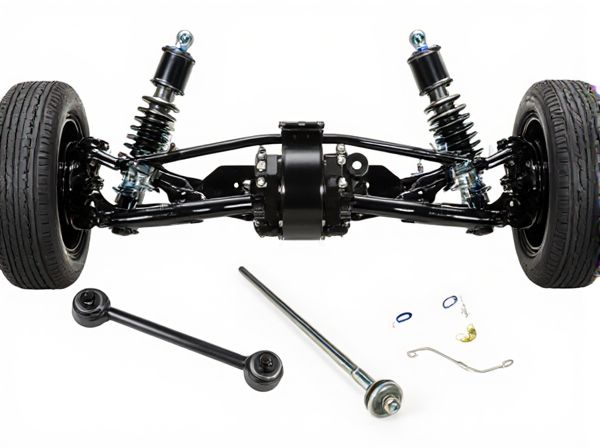
Photo illustration: Multi-Link vs Torsion Beam
Multi-link suspension offers superior handling and ride comfort by allowing each wheel to move independently, reducing road vibrations and improving traction on uneven surfaces. Torsion beam suspension is more cost-effective and simpler, making it ideal for compact vehicles or budget models, but it may sacrifice some ride quality and handling precision. Your choice depends on whether you prioritize performance and comfort or affordability and ease of maintenance.
Table of Comparison
| Feature | Multi-Link Suspension | Torsion Beam Suspension |
|---|---|---|
| Design | Multiple independent links connecting the wheel hub to the chassis | One solid beam connecting both wheels with a twisting mechanism |
| Ride Comfort | Superior - absorbs road irregularities effectively | Moderate - less effective at isolating bumps |
| Handling | Excellent - allows individual wheel movement for better grip | Good - but limited independent wheel movement |
| Space Efficiency | Less space-efficient due to complex components | More space-efficient, allowing larger trunk space |
| Maintenance Cost | Higher - complex setup increases repair costs | Lower - simpler design reduces service expenses |
| Common Use | Mid to high-end vehicles focusing on performance and comfort | Economy and compact cars prioritizing cost and space |
| Weight | Heavier due to multiple components | Lighter with fewer parts involved |
Introduction to Suspension Systems
Multi-link suspension systems offer superior handling and ride comfort by allowing each wheel to move independently with multiple arms controlling motion paths. Torsion beam suspensions use a simpler design with a single beam that twists under load, providing cost efficiency and space savings but limiting wheel independence. Understanding these fundamental differences helps in choosing the right suspension type based on vehicle dynamics, driving conditions, and budget constraints.
What is a Multi-Link Suspension?
A Multi-Link Suspension uses multiple arms or links to control wheel motion independently, providing superior handling and ride comfort by allowing precise wheel alignment adjustments. It improves traction and reduces tire wear by optimizing camber, caster, and toe angles during suspension movement. This setup is commonly found in high-performance and luxury vehicles due to its complexity and enhanced driving dynamics compared to simpler torsion beam systems.
Understanding Torsion Beam Suspension
Torsion beam suspension uses a single, U-shaped steel beam connecting the rear wheels, providing a cost-effective and compact design ideal for small cars. Unlike multi-link suspension, which employs multiple arms and links for independent wheel movement, torsion beam systems offer simpler construction and lower maintenance but sacrifice some handling precision. This suspension type efficiently balances ride comfort and stability by allowing limited wheel independence through the beam's torsional flexibility.
Key Differences Between Multi-Link and Torsion Beam
Multi-link suspension systems use multiple arms to independently control wheel movement, providing superior handling and ride comfort compared to torsion beam setups, which have a single rigid beam connecting wheels. The multi-link design allows for better camber control during cornering, enhancing stability and grip, while torsion beam suspensions offer a simpler, lighter, and more cost-effective solution with limited adjustability. Multi-link suspensions are commonly found in performance and luxury vehicles, whereas torsion beam designs dominate budget-friendly and compact cars.
Ride Comfort and Handling Comparison
Multi-link suspension offers superior ride comfort due to its ability to isolate road imperfections and provide independent wheel movement, reducing cabin vibrations and enhancing passenger comfort. Torsion beam suspension, being simpler and more cost-effective, generally results in a stiffer ride with less refined handling, as it links rear wheels and limits individual wheel articulation. The multi-link setup delivers improved handling responsiveness and stability during cornering, making it preferable for performance-oriented vehicles, while torsion beam is commonly found in compact cars prioritizing cost and space efficiency.
Cost and Maintenance Considerations
Multi-link suspension systems generally incur higher manufacturing and repair costs due to their complex design and increased number of components. Torsion beam suspensions offer a cost-effective solution with simpler construction and lower maintenance requirements, making them popular in budget-friendly vehicles. The reduced complexity in torsion beam setups also translates to fewer potential failure points and decreased labor expenses during servicing.
Space and Weight Implications
Multi-link suspension systems optimize space by allowing independent wheel movement and better packaging of components, often resulting in more trunk and cabin room compared to torsion beam setups. Torsion beam suspensions are simpler and lighter due to fewer parts but can restrict interior space and reduce cargo capacity because of the rigid axle design. Vehicle designers balance these trade-offs, as multi-link systems increase weight and complexity while enhancing ride comfort and spatial efficiency.
Performance in Real-World Driving
Multi-link suspension delivers superior handling and ride comfort in real-world driving by allowing each wheel to move independently, enhancing tire contact and reducing body roll. Torsion beam setups provide a simpler, more cost-effective design but often sacrifice some responsiveness and agility, especially on uneven or rough road surfaces. Real-world performance differences are most noticeable in dynamic driving conditions where multi-link systems maintain better stability and traction.
Applications in Modern Vehicles
Multi-link suspensions enhance handling precision and ride comfort in modern vehicles, making them ideal for luxury sedans, sports cars, and SUVs where dynamic performance is prioritized. Torsion beam suspensions, known for their simplicity and cost-effectiveness, are widely used in compact cars and small crossovers, providing adequate stability and space efficiency. The choice between multi-link and torsion beam systems directly impacts vehicle weight distribution, suspension tuning, and overall driving experience in contemporary automotive design.
Which Suspension System Is Right for You?
Multi-link suspension offers superior handling, ride comfort, and precise road feedback by independently controlling each wheel's movement, making it ideal for drivers prioritizing performance and smoothness. Torsion beam suspension provides a simpler, more cost-effective solution with adequate stability and durability, suitable for everyday commuting and budget-conscious buyers. Choosing between these systems depends on your driving style, budget, and the level of ride quality you desire.
 caratoz.com
caratoz.com